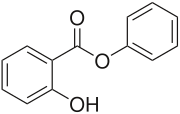Phenyl salicylate
Phenyl salicylate, or salol, is a chemical substance, introduced c. 1883 by Marceli Nencki of Basel. It is synthesized by heating salicylic acid with phenol. Once used in sunscreens, phenyl salicylate is now used in the manufacture of some polymers, lacquers, adhesives, waxes, and polishes.[1] Commonly it is used in school laboratory demonstrations on how cooling rates affect crystal size in igneous rocks. Can be used to demonstrate seed crystal selectiveness. Salol is also used as an internal antiseptic and as a mild analgesic.[3].
 | |
 | |
| Names | |
|---|---|
| IUPAC name
Phenyl 2-hydroxybenzoate | |
| Other names
Salol | |
| Identifiers | |
CAS Number |
|
3D model (JSmol) |
|
| ChEBI | |
| ChEMBL | |
| ChemSpider | |
| ECHA InfoCard | 100.003.873 |
| EC Number |
|
| KEGG | |
| MeSH | C026041 |
PubChem CID |
|
CompTox Dashboard (EPA) |
|
InChI
| |
SMILES
| |
| Properties | |
Chemical formula |
C13H10O3 |
| Molar mass | 214.22 g/mol |
| Appearance | White solid |
| Density | 1.25 g/cm3 |
| Melting point | 41.5 °C (106.7 °F; 314.6 K) |
| Boiling point | 173 °C (343 °F; 446 K) at 12 mmHg |
Solubility in water |
1 g/6670 mL |
Magnetic susceptibility (χ) |
-123.2·10−6 cm3/mol |
Refractive index (nD) |
1.615[2] |
| Pharmacology | |
| G04BX12 (WHO) | |
| Hazards | |
| Flash point | 137.3[2] °C (279.1 °F; 410.4 K) |
Except where otherwise noted, data are given for materials in their standard state (at 25 °C [77 °F], 100 kPa). | |
| Infobox references | |
Salol reaction
In the salol reaction, phenyl salicylate reacts with o-toluidine in 1,2,4-trichlorobenzene at elevated temperatures to the corresponding amide o-salicylotoluide.[4] Salicylamides are one type of drug.
Medical
It has been used as an antiseptic[5] based on the antibacterial activity upon hydrolysis in the small intestine.
References
- Merck Index, 11th Edition, 7282.
- ChemBK Chemical Database http://www.chembk.com/en/chem/Phenyl%20salicylate
- Holden, Alan. "Physics: Crystals 1958". Bell Laboratories - PSSC Physical Science Study Committee. Retrieved 28 January 2018.
- Allen, C. F. H.; VanAllan, J. (1946). "SALICYL-o-TOLUIDE" (PDF). Organic Syntheses. 26: 92.; Collective Volume, 3, p. 765
- Walter Sneader (2005). Drug discovery: a history. John Wiley and Sons. pp. 358–. ISBN 978-0-471-89980-8. Retrieved 28 October 2010.
- Judith Barberio (4 September 2009). Nurse's Pocket Drug Guide, 2010. McGraw Hill Professional. pp. 57–. ISBN 978-0-07-162743-6. Retrieved 28 October 2010.